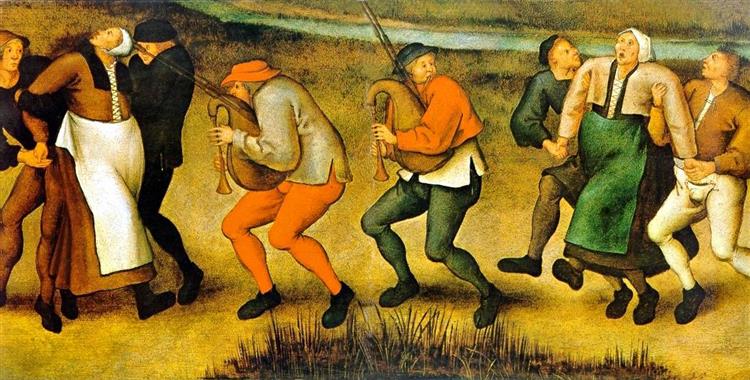Description
The painting "A representation of the mania of dance: on the pilgrimage of epileptics to the Church of Molenbeek" by Pieter Brueghel the young man is a fascinating work that condenses in its composition a particular social and cultural episode of the rebirth. This piece, which finds its origin in the tradition of paintings Of dances, it allows the viewer to introspection in the dynamics of the time, especially with regard to the perception of the disease and the ritual.
From the first glance, the structure of the painting is shocking. In the center of the work there is a multitude of figures that dance with frenzy, their movements are capture of a contagious energy that could be interpreted as much as a celebration and a lament. This ambiguity is a distinctive characteristic of Brueghel's style, who often portrays the complexity of human nature. The expressions in the faces of the dancers reveal a mixture of ecstasy and suffering, referring to the historical context of epilepsy, which at that time was misunderstood and often associated with religious or demonic manias.
The use of color is another critical aspects of the work. Brueghel uses a rich and vibrant palette, where warm tones predominate, suggesting a convulsed festive atmosphere. However, the warmth of colors contrasts with the seriousness of the subject, reflecting the duality of what could be a life celebration that, however, hides the underlying suffering of individuals involved in the dance phenomenon. The brushstroke technique is loose and animated, contributing to the dramatic movement of the scene and capturing the essence of mania with mastery.
The characters that populate paint are varied and different. Brueghel presents a mixture of men and women, young and elderly, who seem to be of various social classes, which is indicative of the scope of the epidemic dance phenomenon. This can be seen in the diversity of clothing and postures. Some characters give themselves to dance while others seem more distant, observing or even trying to help those who succumb to the madness of the dance. This type of representation and social interaction underlines the artist's interest in the human condition and his ability to reflect the connection between the individual and the collective.
In the background, the Church of Molenbeek rises, a reference point that indicates not only the meeting place of the pilgrims, but also the spiritual objective of the dancers. The inclusion of this building brings an additional narrative about the religious fervor that motivates the choreutas to travel, indicating that their actions are both the result of a social phenomenon and of a search for redemption or divine relief. The symmetry of the composition around the Church enhances its importance in the scene, suggesting that, despite the disorder of dance, there is a yearning of order and meaning.
It is interesting to note that this painting is specifically a copy of a previous work by Pieter Brueghel el Viejo, due to the common practice of the artists of the time of reproducing the works of their predecessors. However, young Brueghel does not simply repeat the original work, but imbues it with vibrant energy and emotional complexity that are characteristic of his individual style. Through this creation, the viewer is invited to reflect on the human condition, collective crises and the connection between artistic expression and social experience.
In summary, "a representation of the mania of the dance: about the pilgrimage of epileptics to the Church of Molenbeek" is a masterpiece that transcends its historical context, inviting contemporaries to consider the relations between madness, society and spirituality. Brueghel's ability to capture this complexity in a vivacious and expressionist visualization resonates over the centuries, establishing his place in the Canon of Renaissance art.
KUADROS ©, a famous paint on your wall.
Hand-made oil painting reproductions, with the quality of professional artists and the distinctive seal of KUADROS ©.
Reproduction service paintings With a guarantee of satisfaction. If you are not completely satisfied with the replica of your painting, we refund your money 100%.

